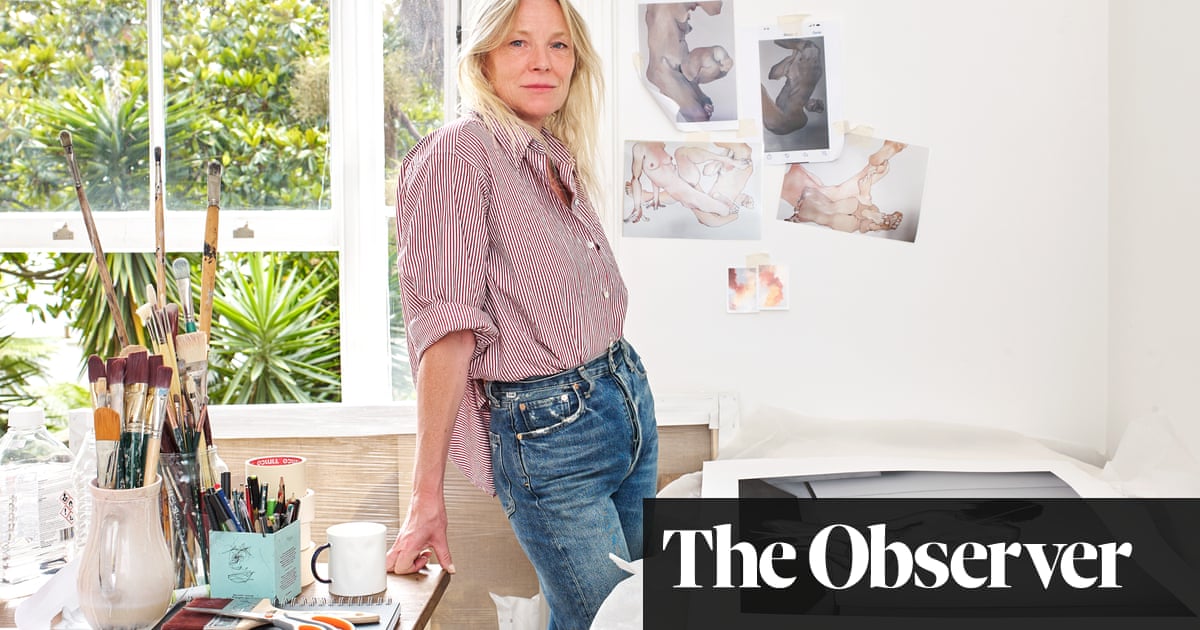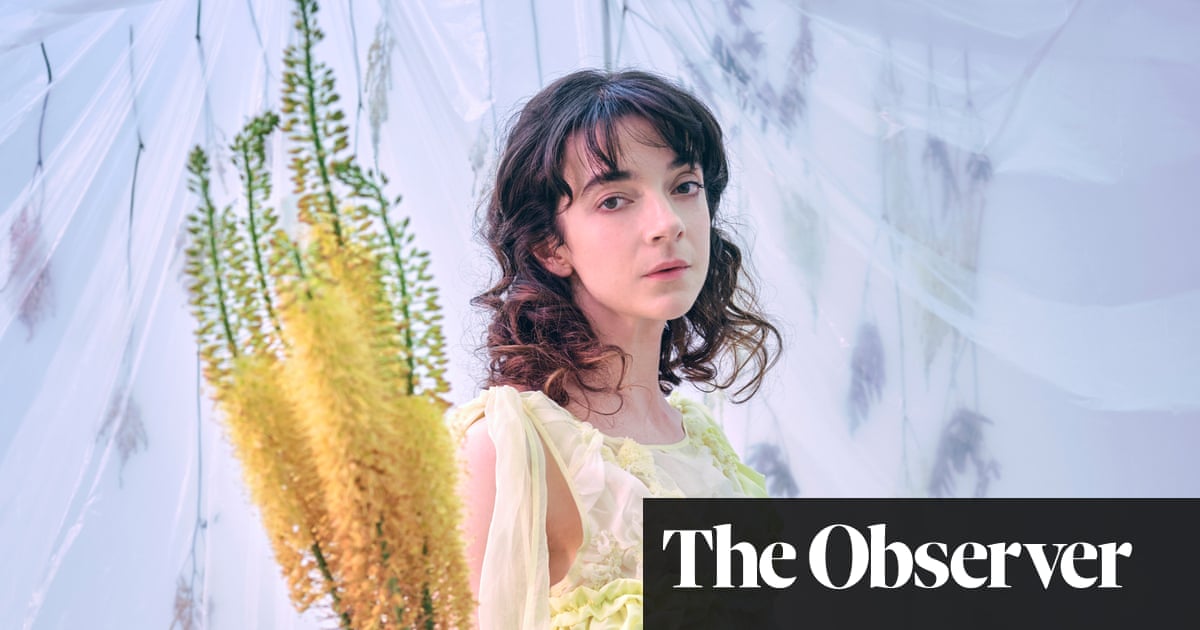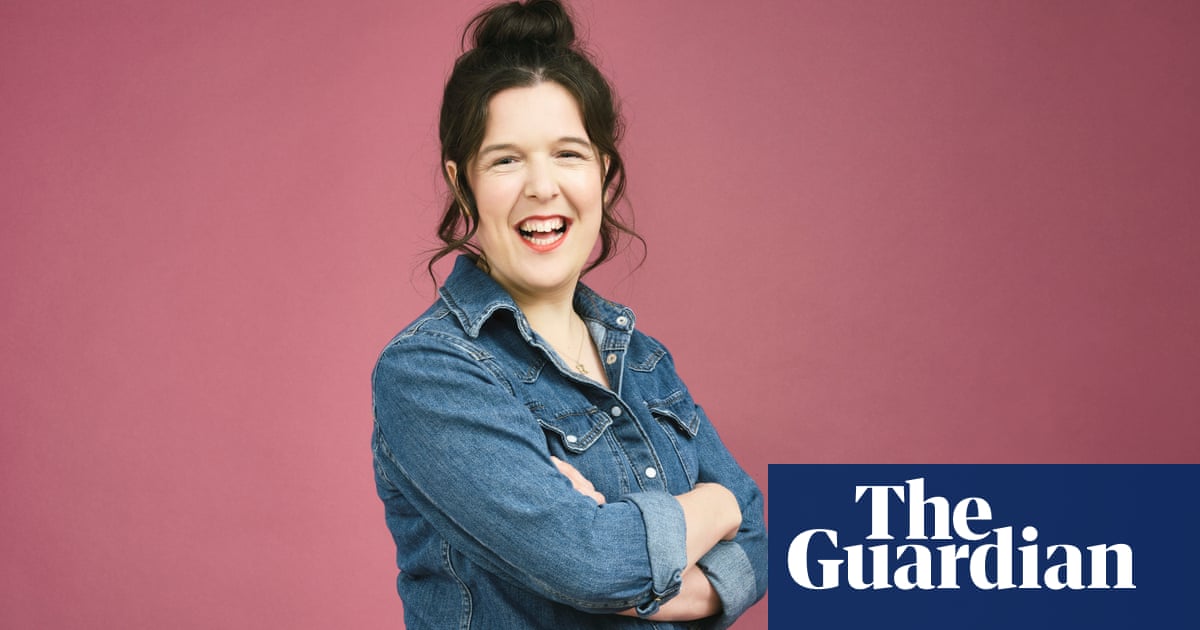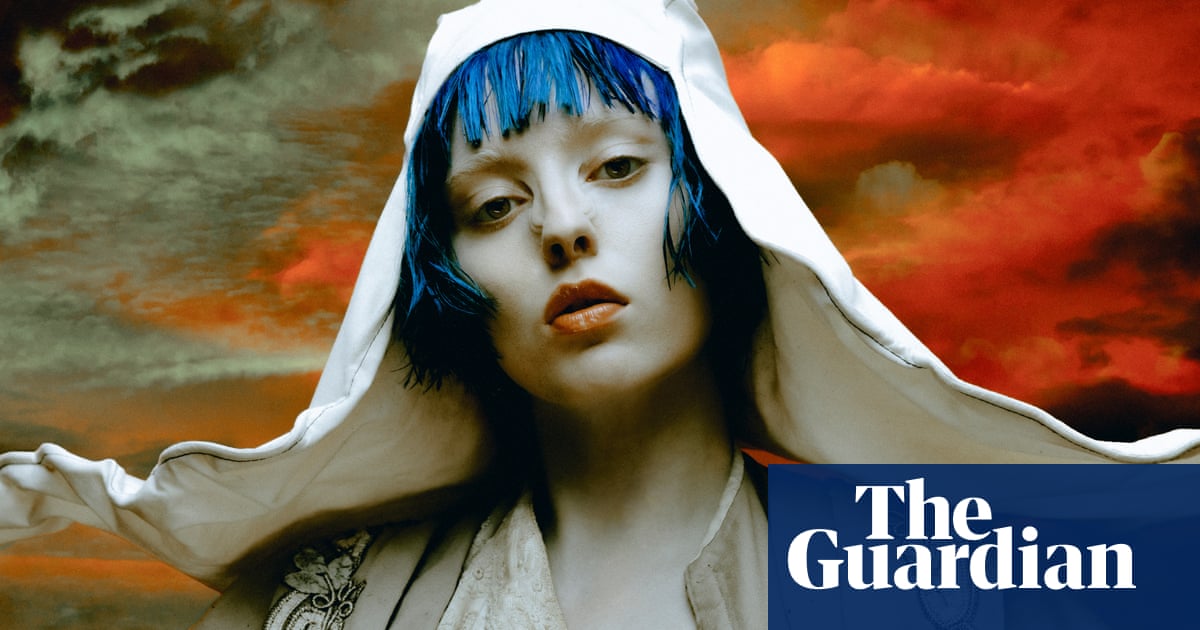
Morning light pours into Luella Bartley’s studio on the first floor of her Bloomsbury townhouse. Palms are visible from the garden below and a tower of art books sits in front of the stone fireplace. There’s a Kae Tempest poetry collection on the wooden work table, alongside jars of paint brushes and scattered black and white photographic cut-outs of disembodied limbs of varying proportions and naked, headless female bodies marked by lines of red ink. There is scant art on the walls – most of the former fashion designer’s paintings and monochromatic photographs are now on display in her new exhibition.
The studio was once the children’s playroom, but they hardly used it. Since then there has been great loss in the family, and today Luella and her two younger children, Stevie, 18, and Ned, 16, are drawn to the small room and to the togetherness and talismanic creativity it affords.
“All of this kind of started with Kip, really,” Luella says of Kip Sims, her eldest son. Kip died in 2021, aged 18, from leukaemia, following a two-and- a-half year illness. She casts a hand across the walls and table. “I mean, he was an incredible artist. He was really, really good.”
Luella and I are meeting in the run-up to her exhibition, Intimate Spaces, a series of large-scale paintings with oil and pencil and monochromatic photographs of twisted, searching, folding naked female forms. She is proud of the work – but ambivalent, the creative process bound up with the loss of Kip: when she is working on a painting, or photographing her life model, Esther, she feels a connection with him. There is a practical benefit, too. “It’s really helpful to get me through the day,” she says.
A pin-up for 90s and noughties punky elegance, Luella went to Central Saint Martins in 1992, aged 18, to study fashion. Uber-stylist Katie Grand was there, too. But Luella, like Grand, did not graduate from the famous art college. Afterwards, the pair shared a tiny flat in Soho, and ran with a fearless creative crowd that included the cult global fashion photographer David Sims, whose 1993 Calvin Klein ads of Kate Moss made the model a star, and who would become Luella’s partner and father of their three children. Grand has recalled their parties and the bath filled with champagne, the pair of them working at Vogue and then at ES magazine. “I was sort of hurtling around London, making lots of mistakes,” says Luella. “When I think about it now, we probably led a quite chaotic, unsafe existence.”
By 1999, the fashion designer had launched her own eponymous label; three years later she designed a handbag for Mulberry that became an It bag; and she published a guide to cool English style. Awarded an MBE for her contribution to fashion in 2008, she put the sass into female fashion, redefining femininity in her luxe-scruffy, empowering image. Today, her art excavates grown-up-girl power, which she has found in the female body, in what she sees as its beauty, ugliness and vulnerability.
“Fashion wasn’t a massive plan of mine,” says Luella, “but I definitely had a drive to get somewhere. I got out of Stratford as soon as I could.”
Luella launched her label, Hillier Bartley, in 2015 with accessories designer Katie Hillier, following two years at Marc by Marc Jacobs. Their collections, featuring pussy-bow blouses, pinched tweeds and battered great coats, were aimed at “the scruffy girl who’d grown up and didn’t necessarily fit into that idea of what middle-aged women looked like”. Patti Smith and Viv Albertine were more her style – “incredible women that don’t really change with age or suddenly go, I’m 40 so I need to wear a skirt.”
An only child, she was brought up by her mother, her parents having split up when her mum was 22 and Luella was only two. Her mother did various administrative jobs. It was “tough” – she was “very, very stressed. She was incredible, but fairly removed and I spent a lot of time on my own. Having the sort of life and family I have now, I realise quite how isolated I was.” She and Sims, an avid surfer, brought up their children first in north London, then Cornwall. For the kids, it was “a totally idyllic childhood,” but “David was travelling so much and it added an extra day to his travel so he wasn’t around so much.” Luella was commuting to London once a week and Kip was struggling at school, so eight years later, in 2015, they moved back to London.
Luella’s own childhood sense of isolation extended to confusion about growing up. “Girlhood, adolescence, the body, sexuality, these things weren’t talked about, things you can’t really figure out on your own. I had friends, but I don’t know if I had really close friends to discuss that stuff, so you just kind of bumble through.”
It’s “incredibly different” for her daughter’s generation, she says. “When I hear Stevie talk with her friends, she is so open and intelligent about femaleness. It makes me realise how naive I was. They feel so much more grounded. They take their space. I don’t think I ever felt like that. I was trying to figure out the world – we’re always trying to figure out the world, aren’t we? It’s always a moving thing.” It’s been a fast journey, she says. “College, career, different careers, children. I don’t think I stopped to reflect. Obviously Kip getting ill was a real stop sign for me. It was full of the most…” She takes a moment, floored by sudden tears, “…the most terrifying and powerless feeling in the world. But he – it – taught me so much. I don’t think I can put it into words, it’s only been two years, and I’m still reeling from it, but so much has changed, internally. I’m a sadder, but braver and more solid person.”
After a long pause, she adds, “and more understanding, you know, of the world. Of what it can give. What it can’t give. I wouldn’t say that I have acceptance, but there is an understanding. It’s strange,” she adds. “It’s strange that you can carry on. What’s the motivation for that? I’ve struggled with that.”
It was 2019 when Kip, doing his GCSEs at the time, had bruises, which Luella assumed were from playing rugby. “But what presented as a bruise was a loss of platelets and then they did his bloods and, the next minute, we were on a cancer ward. It was surreal terror from that moment. It brought everything down,” she says, her speech now barely audible.
“Well, I say that,” and she brings her voice right back up again, “but Kip had – I had – family. And he was extraordinary. His spirit was just so joyous and he never let the disease define him in any way.” Kip was “into everything. He loved fashion, he loved art, he loved music. He was also an incredible athlete – a skater, snowboarder, moto-cross. Any kind of extreme sport. He was wild. He lived. A lot.”
She remembers him feeling better after his first round of treatment had finished. “The next day, off he went. He sent me a picture, he was in the middle of a scrum at Notting Hill carnival and I’m like, ‘Ooh, Kipper, Kipper, Kipper!’
“I didn’t want to get in his way of living. I didn’t want to be that mum who was like, ‘You can’t do that!’ It was always the same – I’d have to bargain with the doctors. There were so many rules, but we got around it every time, and he lived in those two and a half years. He had a great time and his friends were extraordinary and so it wasn’t all awful. There was hope. And we fought. And we had fun.”
The “very loving and supportive” Katie Hillier kept their company ticking over while Luella looked after Kip, including eight months in America, where he was having treatment. But, she says, “he saw me: all I wanted to do was be with him. He was awfully cross that I was sort of giving everything up. He was very clear about what I had to do with my life. He’d say, ‘Just get out there, your friends are amazing, go and see them. Work. Go out there and live.’”
There is a routine to Luella’s days now, at least during term time, though that will change now that Stevie is off to Central Saint Martins herself, to study painting. Luella has been dropping Ned and Stevie off at school, then walking Guido, her dachshund, and Prince, her lurcher, before going to Kip’s memorial log in a local park. “It’s grounding,” she says. “It’s when you feel connected and it’s when you cry, but it’s not always tears of fear or sadness. It’s really important to my every day.”
Friends leave markers of their own visits. “There’s always a beer can or a fag butt, all sorts of strange crystals and stones, lots of flowers.” One day, a friend of Kip’s was “just sitting there, weaving grasses. She wove beautiful hearts. It’s just become a living space.”
Luella is learning how to bring the connectedness she feels there into other aspects of the day-to-day. “It’s definitely in here,” she says of the studio. “I suppose it’s in social situations that I suffer; I lose my connection. So I’m working on that.”
She worked with clay before she concentrated on painting and photography, “because I wanted to get my hands dirty. With fashion, it’s only in your head, you don’t make the thing, and I needed to get out of my head. Every time I do a painting and I like it, I’m like, ‘Thanks Kip.’”
While she has “actively stepped away from fashion,” she does not rule out a return. “There are certain people I would always work for, because I love working with them. I adore Raf [Simons, now of Prada] and Peter [Saville, the graphic designer].” She worked with the pair at Calvin Klein from 2017. “They’re very thoughtful, very clever.”
Her experience of fashion, of “the mask and image and hiddenness,” is at odds with her new “openness and willingness to communicate more”. Besides, there is less freedom in fashion than there once was, she says. “I know people who still have a very creative time in it, but it’s led by money and big brands more than ever. It’s more difficult for a small designer to gain any traction for more than six months.”
Though she has felt conflicted about having an exhibition “and the ambition and the success part of that” in the face of her loss, her work is spectacularly validating. “It feels like a real joy. It’s that real fulfilment in your, like, ‘Fuck, I did that.’”
The painted female forms in the exhibition, all depicted from the neck downwards, are fleshy and soft, with a deliberate hardness to the pencil outlines. The photographs feel brutal, the bodies marked by “very hard, quite extreme armature lines”. They conjure a brittleness, which “spoke to me of the quite fragile frames within us – the flip sides of fleshy, soft femininity.
“Femininity can be ugly. We bleed. It’s profound and it’s big and it somehow can be taboo. I want to beautify that, or at least give it some power or some presence.”
There is negative space around each painted nude. “A friend said they look like they are trying to break out of the canvas. That feels like a metaphor for what is going on within me.”
Luella is proud of Stevie and Ned, who adored their big brother. For all three of them, art has been “a lifeline” since his passing. For her part, Luella seeks “to find that balance between connection and distraction. To explore, to have that curiosity again, is amazing, because I really am not sorted. It feels like the beginning of a really exciting experiment. I just can’t wait to do more work.
“That is my aim: to be able to feel connected. And to work out how to live here – in this world.”












